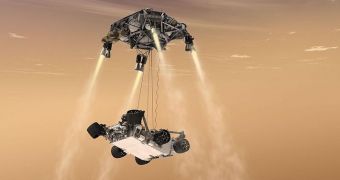A few days ago, when the strongest solar flare to occur on the surface of the Sun since 2005 struck the Earth, the shock waves also headed for Mars, and then further out into the solar system. On its way, it met the Radiation Assessment Detector aboard the NASA Mars Science Laboratory spacecraft.
The MSL is currently on its way to the Red Planet, where it is scheduled to land in August. The RAD is one of the few instruments that are activated at this time, since it's main purpose is to analyze the amount of space radiations a human crew would endure during a months-long trip to Mars.
The solar event occurred yesterday, January 27, and caused an S3-class solar storm. This in turn released a vast volumes of electrically-charged particles, which began spreading through the solar system. Thus far, the MSL appears to have remained immune to the event's effects.
The Coronal Mass Ejection (CME) and its influence on the planet, Mars and the MSL were simulated in a new model compiled by experts at the NASA Goddard Space Weather Lab (GSWL).
Solar physicists expect the next few days to see more auroras developing above the North Pole. These events are bound to be so luminous that they could even be observed from lower latitudes. The CME may also affect satellites in Earth's orbit.
Additional effects could be felt on GPS systems, as well as on airplanes and power grids. In fact, most electronics and their components are susceptible to the effects of solar flares, SpaceRef reports.
The Solar Dynamics Observatory, GOES, the Advanced Composition Explorer, the twin STEREO spacecraft and the Solar Heliospheric Observatory (SOHO) also observed the phenomenon and its aftermath.
“RAD was designed to characterize radiation levels on the surface of Mars, but an important secondary objective is measuring the radiation during the almost nine-month journey through interplanetary space to prepare for future human exploration,” explains Don Hassler.
“RAD is an important bridge between the science and exploration sides of NASA,” adds the expert, who is the science program director at the Southwest Research Institute's Space Studies Department. He is also the principal investigator for the instrument.

 14 DAY TRIAL //
14 DAY TRIAL //